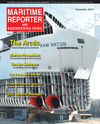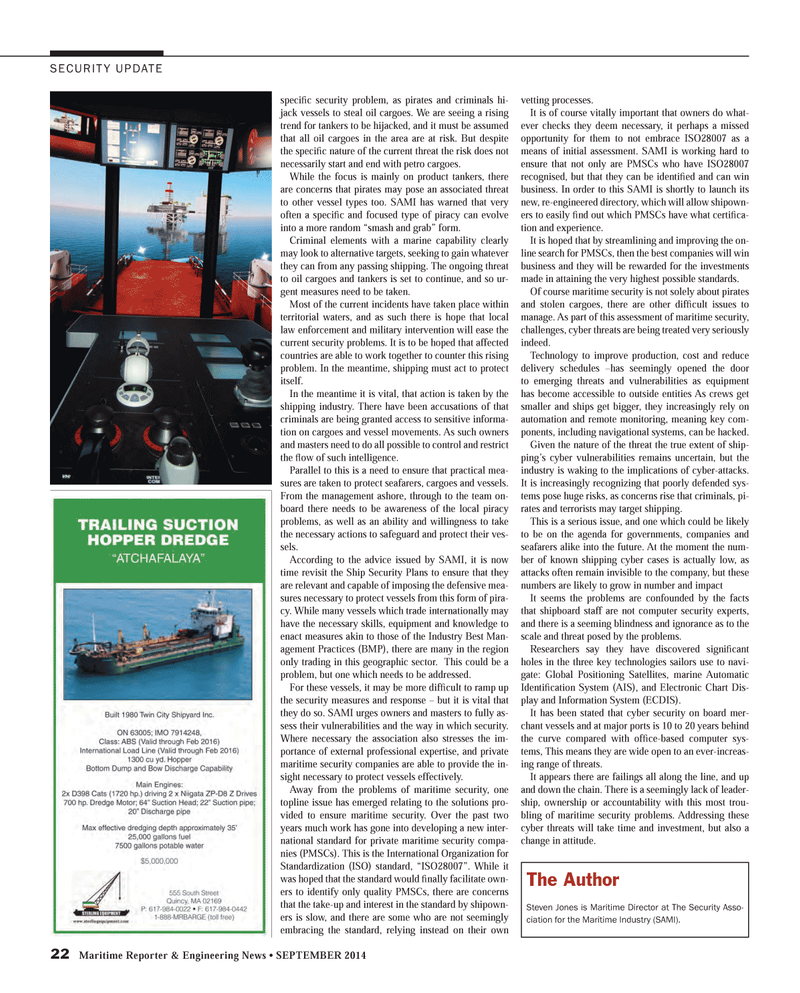
Page 22: of Maritime Reporter Magazine (September 2014)
Marine Propulsion Edition
Read this page in Pdf, Flash or Html5 edition of September 2014 Maritime Reporter Magazine
22 Maritime Reporter & Engineering News • SEPTEMBER 2014
SECURITY UPDATE specifi c security problem, as pirates and criminals hi- jack vessels to steal oil cargoes. We are seeing a rising trend for tankers to be hijacked, and it must be assumed that all oil cargoes in the area are at risk. But despite the specifi c nature of the current threat the risk does not necessarily start and end with petro cargoes.
While the focus is mainly on product tankers, there are concerns that pirates may pose an associated threat to other vessel types too. SAMI has warned that very often a specifi c and focused type of piracy can evolve into a more random “smash and grab” form.
Criminal elements with a marine capability clearly may look to alternative targets, seeking to gain whatever they can from any passing shipping. The ongoing threat to oil cargoes and tankers is set to continue, and so ur- gent measures need to be taken.
Most of the current incidents have taken place within territorial waters, and as such there is hope that local law enforcement and military intervention will ease the current security problems. It is to be hoped that affected countries are able to work together to counter this rising problem. In the meantime, shipping must act to protect itself.
In the meantime it is vital, that action is taken by the shipping industry. There have been accusations of that criminals are being granted access to sensitive informa- tion on cargoes and vessel movements. As such owners and masters need to do all possible to control and restrict the fl ow of such intelligence.
Parallel to this is a need to ensure that practical mea- sures are taken to protect seafarers, cargoes and vessels.
From the management ashore, through to the team on- board there needs to be awareness of the local piracy problems, as well as an ability and willingness to take the necessary actions to safeguard and protect their ves- sels.
According to the advice issued by SAMI, it is now time revisit the Ship Security Plans to ensure that they are relevant and capable of imposing the defensive mea- sures necessary to protect vessels from this form of pira- cy. While many vessels which trade internationally may have the necessary skills, equipment and knowledge to enact measures akin to those of the Industry Best Man- agement Practices (BMP), there are many in the region only trading in this geographic sector. This could be a problem, but one which needs to be addressed.
For these vessels, it may be more diffi cult to ramp up the security measures and response – but it is vital that they do so. SAMI urges owners and masters to fully as- sess their vulnerabilities and the way in which security.
Where necessary the association also stresses the im- portance of external professional expertise, and private maritime security companies are able to provide the in- sight necessary to protect vessels effectively.
Away from the problems of maritime security, one topline issue has emerged relating to the solutions pro- vided to ensure maritime security. Over the past two years much work has gone into developing a new inter- national standard for private maritime security compa- nies (PMSCs). This is the International Organization for
Standardization (ISO) standard, “ISO28007”. While it was hoped that the standard would fi nally facilitate own- ers to identify only quality PMSCs, there are concerns that the take-up and interest in the standard by shipown- ers is slow, and there are some who are not seemingly embracing the standard, relying instead on their own vetting processes.
It is of course vitally important that owners do what- ever checks they deem necessary, it perhaps a missed opportunity for them to not embrace ISO28007 as a means of initial assessment. SAMI is working hard to ensure that not only are PMSCs who have ISO28007 recognised, but that they can be identifi ed and can win business. In order to this SAMI is shortly to launch its new, re-engineered directory, which will allow shipown- ers to easily fi nd out which PMSCs have what certifi ca- tion and experience.
It is hoped that by streamlining and improving the on- line search for PMSCs, then the best companies will win business and they will be rewarded for the investments made in attaining the very highest possible standards.
Of course maritime security is not solely about pirates and stolen cargoes, there are other diffi cult issues to manage. As part of this assessment of maritime security, challenges, cyber threats are being treated very seriously indeed.
Technology to improve production, cost and reduce delivery schedules –has seemingly opened the door to emerging threats and vulnerabilities as equipment has become accessible to outside entities As crews get smaller and ships get bigger, they increasingly rely on automation and remote monitoring, meaning key com- ponents, including navigational systems, can be hacked.
Given the nature of the threat the true extent of ship- ping’s cyber vulnerabilities remains uncertain, but the industry is waking to the implications of cyber-attacks.
It is increasingly recognizing that poorly defended sys- tems pose huge risks, as concerns rise that criminals, pi- rates and terrorists may target shipping.
This is a serious issue, and one which could be likely to be on the agenda for governments, companies and seafarers alike into the future. At the moment the num- ber of known shipping cyber cases is actually low, as attacks often remain invisible to the company, but these numbers are likely to grow in number and impact
It seems the problems are confounded by the facts that shipboard staff are not computer security experts, and there is a seeming blindness and ignorance as to the scale and threat posed by the problems.
Researchers say they have discovered signifi cant holes in the three key technologies sailors use to navi- gate: Global Positioning Satellites, marine Automatic
Identifi cation System (AIS), and Electronic Chart Dis- play and Information System (ECDIS).
It has been stated that cyber security on board mer- chant vessels and at major ports is 10 to 20 years behind the curve compared with offi ce-based computer sys- tems, This means they are wide open to an ever-increas- ing range of threats.
It appears there are failings all along the line, and up and down the chain. There is a seemingly lack of leader- ship, ownership or accountability with this most trou- bling of maritime security problems. Addressing these cyber threats will take time and investment, but also a change in attitude.
The Author
Steven Jones is Maritime Director at The Security Asso- ciation for the Maritime Industry (SAMI).
MR #9 (18-25).indd 22 9/5/2014 12:08:39 PM

 21
21

 23
23
